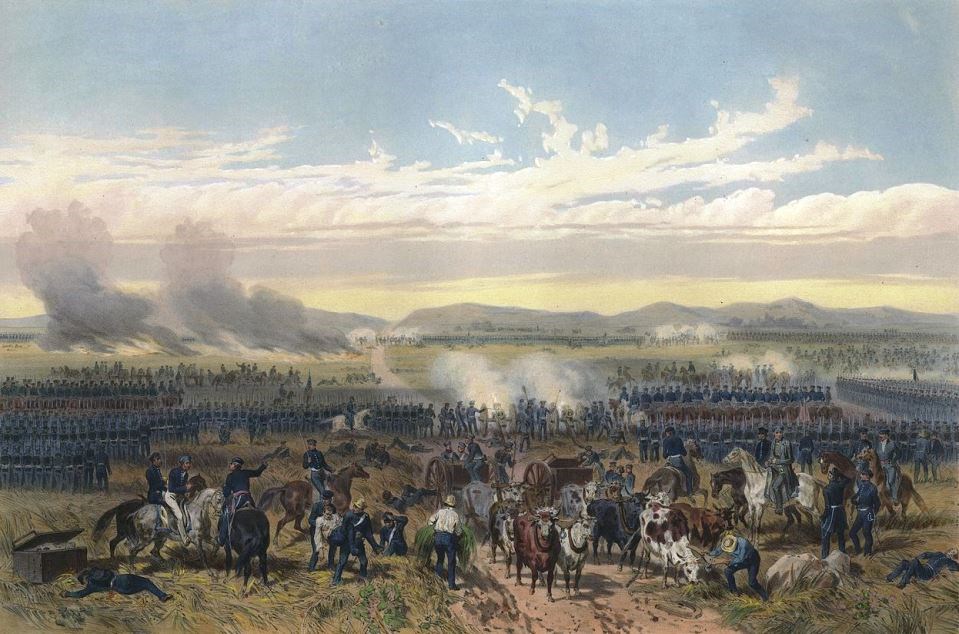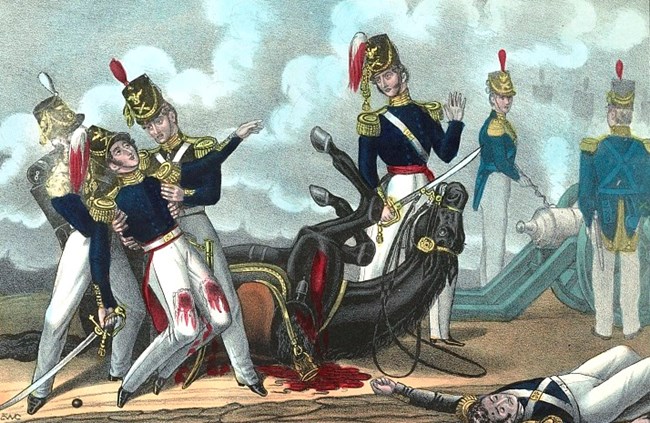
Adolphe Jean-Baptiste Bayot, Carlos Nebel {PD-US} Natural BattlefieldThe prairie of Palo Alto was naturally suited for the first battle of the Mexican War. The low-lying, coastal prairie was surrounded by tree covered rises that inspired its Spanish name, "Tall Timber." The Matamoros to Point Isabel Road crossed the vast field on the western end. It was this very road Zachary Taylor's force of 2,300 men and 400 wagons were following. Taylor ArrivesGeneral Taylor arrived at Palo Alto around midday on May 8. As U.S. troops marched out of the cover of mesquite thickets at the northern edge of the field, they paused to entrench their supply train. When this was done, they advanced to within 700 yards of the Mexican lines. The stage was set. The Battle BeginsWhen the Mexican cannon began firing, U.S. troops assumed battle formation, but did not advance to engage Mexican forces. General Taylor feared a charge would leave his supply train vulnerable to attack. The general decided to hold his infantry and cavalry in a defensive formation and rolled his artillery forward to respond. Arista RespondsArista attempted to answer the devastating effects of Taylor’s artillery by sending cavalry troops against the right flank of the U.S. line. General Anastasio Torrejón's lancers swept across the western edge of the field, but soon became bogged down by the uneven ground and dense growth. 
Library of Congress (no known restrictions) Combat ContinuesWhen the smoke cleared, the U.S. artillery resumed its devastating fire on the Mexican lines. Mexican artillerymen responded by directing their guns at the U.S. artillery, hoping to bring relief from the assault. The tactic met with limited effect but did strike one heavy blow Taylor’s force. One round from the Mexican artillery mortally wounded Samuel Ringgold, the mastermind behind the U.S. light artillery. Fighting FadesAt 7 p.m. the fierce, four-hour cannonade came to an end. Mexican forces had depleted their ammunition and withdrew to the southern edge of the field. With darkness approaching and the ever-present concern for the safety of his supply train, General Taylor retired as well. U.S. forces set up camp behind their lines and prepared to resume fighting the following morning. Advantage TaylorMexican troops had delayed the U.S. advance and maintained their siege of Fort Texas, but the Battle of Palo Alto had clearly favored Taylor's forces. The constant pounding from U.S. 18-pounders and efficient use of light field pieces had inflicted heavy Mexican casualties. Arista's army suffered 102 killed, 129 wounded, and 26 missing. U.S. casualties numbered only 9 killed, 44 wounded, and 2 missing. These casualty figures prompted General Arista to reject a second day of battle at Palo Alto. After spending much of the night burying their dead, Mexican forces withdrew early the next morning to Resaca de la Palma. The two armies would clash here for second time. This battle Taylor and his men would win decisively. 
NPS/ Helen Dhue The Site TodayPalo Alto has escaped much of the development that has swept across the lower Rio Grande Valley, retaining much of its 1846 character. It is a vast plain still features razor-sharp cordgrass, dense thickets of mesquite, cactus and other thorny plants. Palo Alto vividly recalls the scene described by soldiers in dozens of letters and diary entries. |
Last updated: June 24, 2025
